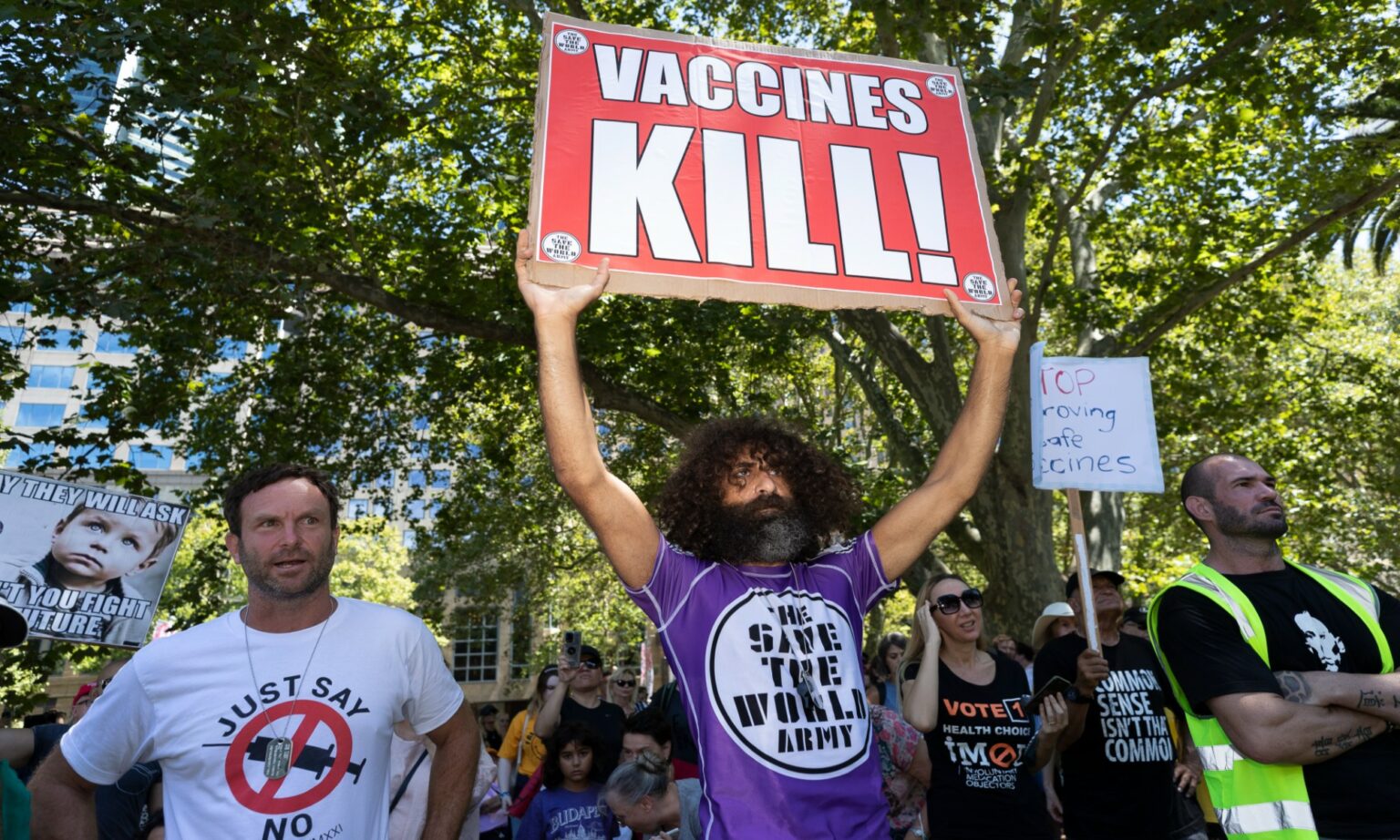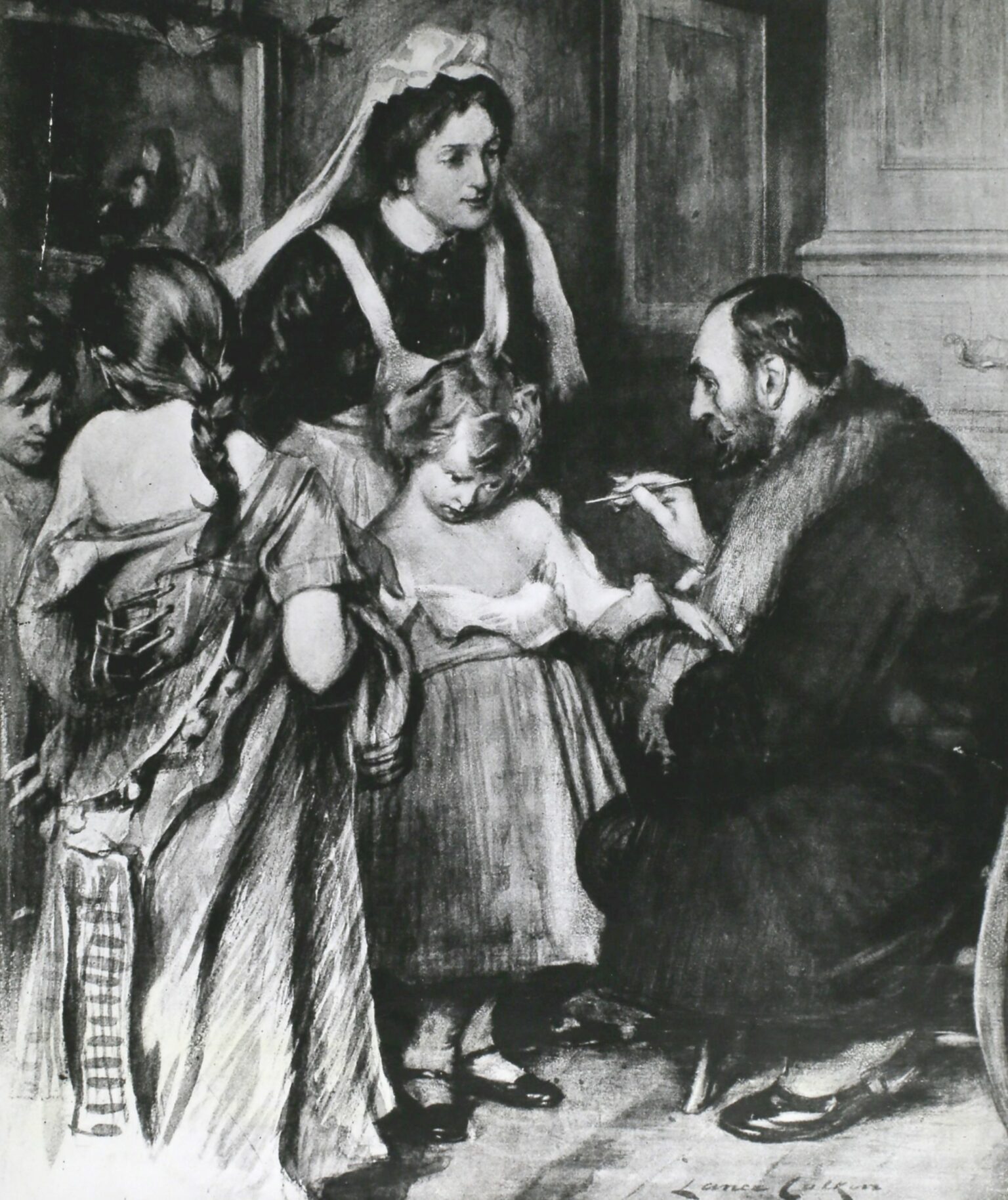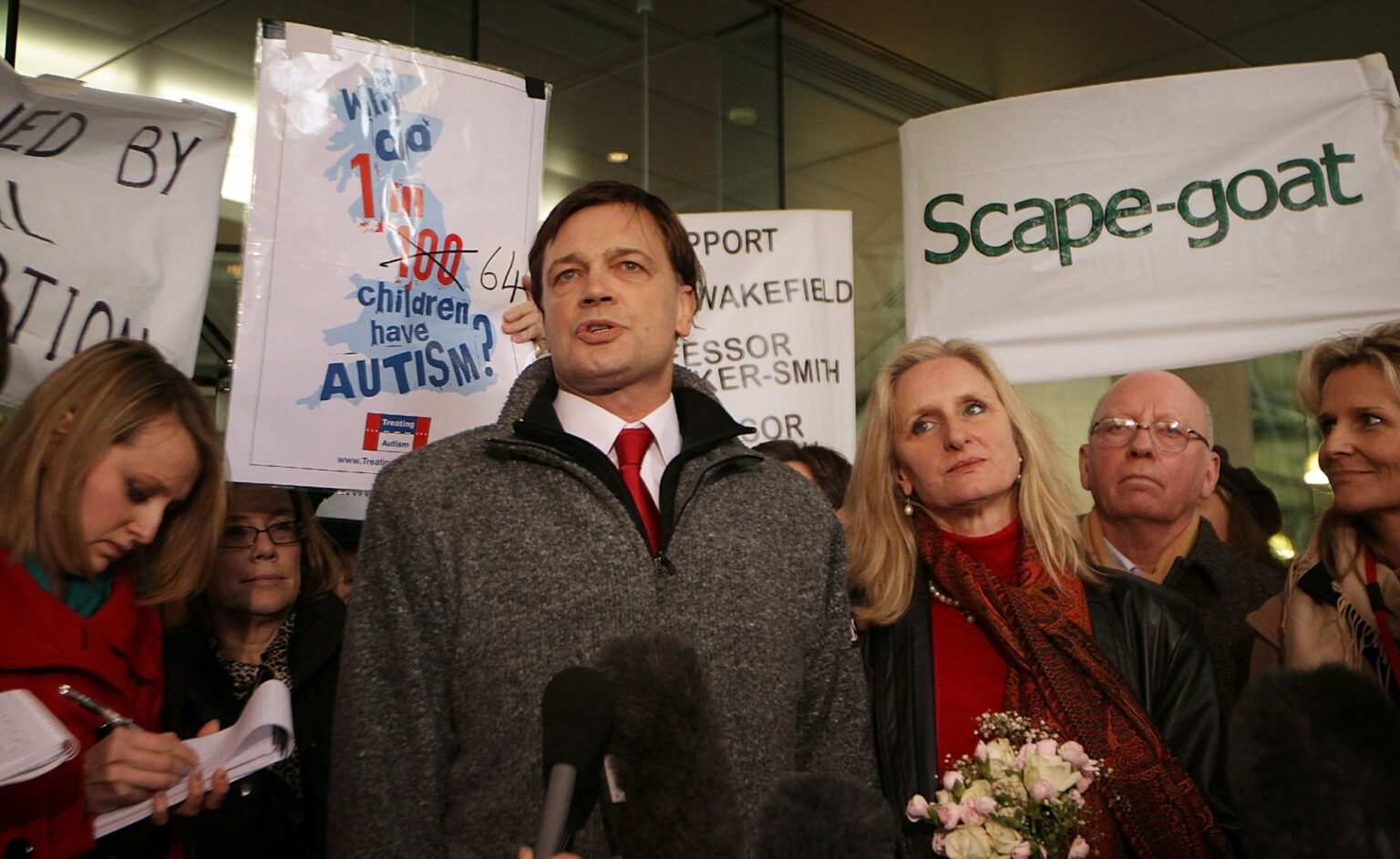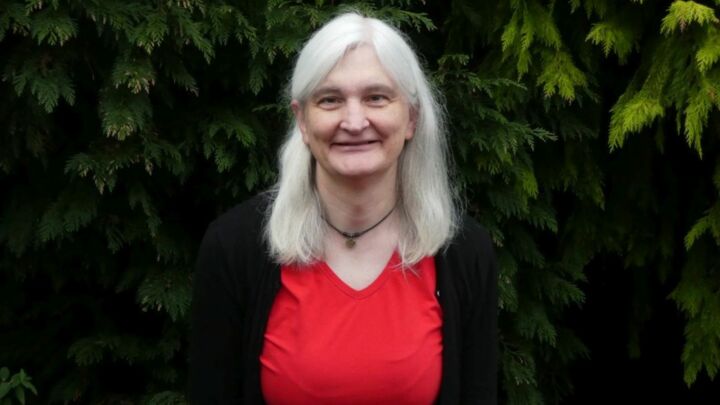
Long-read
The ‘respectable’ roots of the anti-vax movement
Anti-vaxxers are drawing on decades of middle-class hysteria.
As long as there have been vaccines, there has been opposition to them. That’s why many historians have drawn attention to the continuity between yesterday’s refuseniks and today’s anti-vaxxers, conspiracy theory in one hand, social-media megaphone in the other. But this emphasis on continuity is misleading. For it obscures what is most regressive about anti-vaccination sentiment today.
There is certainly much that looks familiar about anti-vaccination sentiment in the past. Take the attempts to inoculate people against smallpox in 18th-century Britain. The practice of variolation, which involved rubbing the scabs of smallpox victims on to recipients’ freshly scratched skin, was risky, but effective in most cases. Senior members of the Church of England, however, condemned it as outright unsafe and, more importantly, immoral – Reverend Edmund Massey’s A Sermon Against the Dangerous and Sinful Practice of Inoculation (1722) was a particular classic of the theological anti-vaxxer genre.
Edward Jenner’s experiments with cowpox in the 1790s, which culminated in the first vaccination proper against smallpox, were met with similar fear and loathing from some quarters. As ever, many worried about the real and potential dangers of this new medical technique – sentiments captured well by satirist James Gillray’s 1802 cartoon, ‘The Cow-Pock’, in which the inoculated are depicted sprouting small cows.
Vaccination has always been accompanied by a degree of anxiety over its potentially adverse consequences. And as this week’s violent protests against lockdowns, vaccine passes and vaccine mandates in Europe show, moves towards compulsion always prompt resistance and reinforce anti-vaccination sentiment.
The British government encountered precisely this when it made smallpox vaccination mandatory for all infants in 1853, and then for all under-14s in 1867 – complete with harsh financial punishments. At a time of simmering class tension and distrust towards the ruling authorities, such moves were experienced by some as an attempt by the authorities to regulate and monitor their private lives. In response, refuseniks formed the Anti-Vaccination League and the Anti-Compulsory Vaccination League, and agitation ensued in many of England’s overcrowded urban centres. This was particularly pronounced in Leicester, where in 1885 over 80,000 demonstrators marched through the city centre. As one historian puts it, the protesters were carrying ‘banners, a child’s coffin and an effigy of [Edward] Jenner’.
In America, anti-vaccination sentiment also crystallised during the 19th century in response to vaccine mandates in several states. The Anti-Vaccination Society was formed in 1879, and those who refused smallpox jabs had taken to calling themselves ‘conscientious objectors’ – a phrase that was only later adopted by unwilling conscripts. In other words, it was mandatory vaccination that allowed people to reframe their refusal to get the jab as a matter of autonomy.
For example, in 1902, after smallpox had broken out in Cambridge, Massachusetts, the city’s health board ordered the vaccination of all citizens. Henning Jacobson, a local pastor who blamed a childhood vaccination for an illness he endured, described the law as ‘unreasonable, arbitrary and oppressive’, and as an invasion of his liberty and a threat to his children. His opposition to vaccine mandates eventually made it to the US Supreme Court, which ruled in Massachusetts’ favour. But that merely galvanised the anti-vaccination lobby in the US, prompting, in 1908, the formation of the Anti-Vaccination League of America.
It can often look as if nothing has changed – that the dynamic informing 19th-century vaccine refusal is at work throughout the 20th and 21st centuries, too.
But there is also a lot that separates the resistance to the smallpox jab and the anti-vaxxer hardcore of today. For a start, vaccination in the 19th century was a considerably more risky affair. It was often carried out in unsanitary conditions, and with far less sophisticated and rigorously tested products. The risks to health were therefore very real, although obviously not as real as those posed by smallpox itself, which killed hundreds of millions in the 20th century alone.

Moreover, by the time the first effective polio vaccine was developed in 1952, by Jonas Salk and researchers at the University of Pittsburgh, public confidence was such that resistance to the vaccine was low to non-existent. Of course there were those on both sides of the Atlantic who cast doubt on its efficacy, and some certainly objected to it being made compulsory. But there was far greater confidence and trust in medical science and public-health authorities than there had been in the 1850s.
So in many ways, given the medical progress we have made since the 1950s, one might expect that there would be even greater acceptance of vaccinations today. The huge, life-saving benefits – the eradication of killer diseases – are by now completely unquestionable. And thanks to the huge advances in medical science, vaccinations are more effective and safer than they have ever been.
And yet, anti-vaccine sentiment seems to have waxed rather than waned. Indeed, as the prominence of Covid anti-vaxxers and their influence over the so-called vaccine-hesitant have shown over the past year, anti-vaccination sentiment has flourished. And it has done so at a time when it has never been more irrational.
Partly, this is down to the imposition of lockdown measures around the globe, and the use and abuse of science to justify them. Some of those intensely frustrated and angered by lockdowns have, after their relaxation, transferred their long-brewing animus from lockdowns to any government-encouraged measure, including vaccination programmes.
But the eruption of anti-vaxxer sentiment over the past year also has deeper historical roots. These reach back to the growing disillusionment with modernity that first started to gain widespread traction in the West during the 1970s.
The postwar boom had ended and economic stagnation had set in. The Vietnam War had exposed the limits of US power. And deeper still, there was a growing disenchantment with industrial and technological progress, with modernity itself. It felt like a process apart from people, a process over which they had no control. The unintended consequences of modernity started to appear worse than the intended benefits – sentiments which were writ large in the then emergent environmentalist movement.
It is in this context that anti-vaccination sentiment starts to gain broader cultural and political validation. Media and politicians, imbibing and promoting the increasingly anti-modern tenor of the times, were willing to sympathise with, encourage and support anti-vaccination arguments, no matter how wrongheaded.
In the early 1970s, for instance, Dr John Wilson and colleagues at Great Ormond Street Hospital claimed a link between the pertussis or whooping-cough vaccine and a form of brain damage known as encephalopathy. In 1973 Wilson helped to form the Association of Vaccine Damaged Children and led a campaign, backed by distressed parents, against the pertussis vaccine.
No evidence was found to prove his contention that the vaccine was causing brain damage in children. Two decades earlier, that would have been the end of the matter. Instead, Wilson’s claims were treated credulously. In April 1974, recalled journalist Brian Deer, ITV broadcast a half-hour, prime-time This Week documentary concentrating on the plight of one of Wilson’s patients. It unequivocally blamed the vaccine and asserted that ‘every year about 100 [children are] brain damaged’.
In the US, an NBC documentary also based on Wilson’s claims aired in 1982. DPT: Vaccine Roulette is widely recognised as a key moment in the development of the contemporary anti-vaxxer movement.
The turn against modernity, science and experimentation only intensified during the 1980s and the 1990s. This was the moment of sociologist Ulrich Beck’s ‘risk society’, when technological and scientific development was framed as the source of humanity’s undoing. The moment when environmentalists talked up acid rain. The moment when green activists would tear through fields of genetically modified crops, claiming such crops were contaminating the food chain. Humanity’s interaction with nature in all its forms was being reframed as a source of often dire unintended consequences, from toxins in the food chain to global warming.
Anti-vaccine sentiment grew unchallenged during this era. Much of the so-called respectable news media, which now rails against anti-vaxxers, seemed to sympathise with them, and even support them. As Bernice Hausman argues in Anti/Vax (2019), mainstream-media reporting ‘on parent vaccine-watchdog groups… was respectful about parental concerns about vaccination risks’. Indeed, as Hausman points out, in the mid-1990s many liberal journalists were more than happy to maintain that so-called Gulf War Syndrome, a multi-symptom disorder affecting soldiers returning from war, could well be a product of the vaccinations against anthrax and botulinum toxin given to military personnel.
Is it any wonder that the signal moment in modern anti-vax history took flight during the 1990s? After all, this was a time when science, technology and even modernity itself were being cast by the mainstream media and assorted politicians as the very wellspring of future risk and harm.
In an earlier era, Dr Andrew Wakefield’s infamous 1998 Lancet paper, which alleged a connection between the MMR (measles, mumps, and rubella) vaccine and autistic enterocolitis, might have been quickly dismissed out of hand. After all, Wakefield’s claims, which were based on shoddy research and a conflation of correlation with causation, were taken apart by experts soon after publication.

But Wakefield was lauded and praised. The Lancet, to its eternal shame, refused to retract the paper for over a decade. And worse still, Wakefield’s claims were taken up with crusading zeal by the media. He was treated to endless favourable write-ups in the UK broadsheet press, and even to a 2003 Channel Five docu-drama, in which he was played as a whistle-blowing hero by Hugh Bonneville. And all this long after medical practitioners had debunked Wakefield’s claims. In 2002, Lorraine Fraser, the author of countless anti-MMR articles in the Daily Telegraph, earned herself a Health Reporter of the Year award. And that bastion of the anti-establishment establishment, Private Eye, pushed the anti-vaxxer line in a 32-page special report entitled ‘MMR: The Story So Far’.
In America, Wakefield’s cause was taken up with similar enthusiasm during the 2000s, especially by celebrities, including Jenny McCarthy, Alicia Silverstone, Rob Schneider and Robert De Niro. Politician Robert F Kennedy Jr penned a famous Rolling Stone article in 2005, entitled ‘Deadly immunity’, in which he alleged a government cover-up of the dangers of mercury in vaccines.
The support for Wakefield’s anti-vaxxer shtick among the left-leaning and liberal gives the lie to claims that the opposition to the Covid vaccine is a product of right-wing populism. Indeed, what is remarkable about the anti-vaxxer movement during the 2000s is just how liberal, right-on and middle-class it was. To be at least sceptical about vaccinating your children was deemed to be a mark of good, responsible parenting. To talk darkly of Big Pharma, and its ruthless pursuit of profit, was a sign of just how informed and anti-capitalist you were. And to reject aspects of the modern world as artificial and dangerous was a surefire way to demonstrate your virtue.
A New York Times piece from 2019 captures well the interlocking features of this anti-modern worldview. It tells the story of Dana Fuqua, who in 2011 had just moved to the comfortable, middle-class town of Aurora in Colorado. Expecting her first child, she found herself pulled into the right-on world of modern parenting – and with it, towards the perspective of an anti-vaxxer. As the NYT puts it, she was urged to ‘have a drug-free birth, use cloth diapers and never to let a drop of formula pass her baby’s lips. Vaccines, it followed, were anathema.’
By the early 2010s, with Wakefield having been struck off by the General Medical Council and the Lancet finally retracting his paper, there was a turn against the growing anti-vaxxer movement on the part of media and political elites. The sympathetic championing of their cause was replaced by scolding and chiding. ‘How the anti-vaccine movement threatens us all’, ran one 2011 headline. Slate magazine, which 15 years earlier had mooted the possible connection between Gulf War Syndrome and vaccinations, even made the case for prosecuting parents who refused to vaccinate their children. Other publications, such as Salon and Rolling Stone, publicly announced that they were removing their anti-vaxxer content.
But the cultural underpinnings of the anti-vaxxer movement remained in place. The authority of public institutions had been near-fatally undermined. Big Pharma, which had been beset by a series of scandals, was still seen as part of a conspiracy to get rich at the expense of people’s health. And the general climate of fear persisted. Our technological, material progress – including medical progress – was felt to be sowing the seeds of our destruction. And so, during the 2010s, anti-vaccination sentiment persisted, too. Indeed, being told by the great and the good that they were deluded, immoral and deserving of prosecution only reinforced anti-vaxxers’ sense of paranoid self-righteousness.
It seems that having encouraged and authorised anti-vaccination sentiment, from the 1980s until the early 2000s, cultural and political elites have been unable to rein it back in. Indeed, in recent years, in the UK and the US, measles, having hitherto been eradicated, has slowly been making a comeback thanks to the lower uptake of the MMR vaccine. Little wonder that, on the eve of the Covid pandemic, the World Health Organisation listed vaccine hesitancy as one of the top threats to global health.
Covid and the lockdown have merely supercharged this long-standing anti-vaccination sentiment. Too many critics have been predictably quick to blame it on populism. They wilfully and wrongly equate the popular rejection of technocracy in 2016 with a minority’s rejection of medical science in 2021. In truth, today’s vaccine refuseniks come from across the political and social spectrum. They encompass conspiracy theorists from the far right and the far left, with both sets certain that lockdowns and vaccines are the product of a global plot to exert ever more control over us. And the Covid anti-vaxxers draw in the same middle-class constituencies – the worried parents, the arch cynics, and the wellness and wellbeing enthusiasts – that have long been immersed in the anti-vaxxer universe.
There is plenty of reason for optimism, however. The vaccine-hesitant are not the same as the small hardcore of committed anti-vaxxers. Their reluctance is not a firmly held conviction, let alone a part of their identity. It’s a momentary reticence. And as such, they can easily change their minds. As research at University College London showed earlier this year, more than four in five (86 per cent of) people who were unsure or said no to a Covid-19 vaccine in December 2020 were willing to take one by March 2021. Even in the US, where vaccine hesitancy is considered a greater problem than it is in the UK, research has shown that more and more people are coming round. A recent survey suggested that two thirds of hitherto vaccine-hesitant respondents had, by October, either received at least one dose or were about to receive one.
The lesson is clear enough. Anti-vaxxers are not the main obstacle to raising vaccination levels. They are only as influential as they are allowed to be – by a cultural and political climate that validates and echoes their concerns. If we stick up for medical science, and affirm and defend vaccines as a wondrous achievement, many of the reluctant and doubtful will change their minds. And they will do so of their own accord. But force them through mandates and, as history really does show, their resistance will intensify.
Tim Black is a spiked columnist.
Pictures by: Getty
To enquire about republishing spiked’s content, a right to reply or to request a correction, please contact the managing editor, Viv Regan.








Comments
Want to join the conversation?
Only spiked supporters and patrons, who donate regularly to us, can comment on our articles.